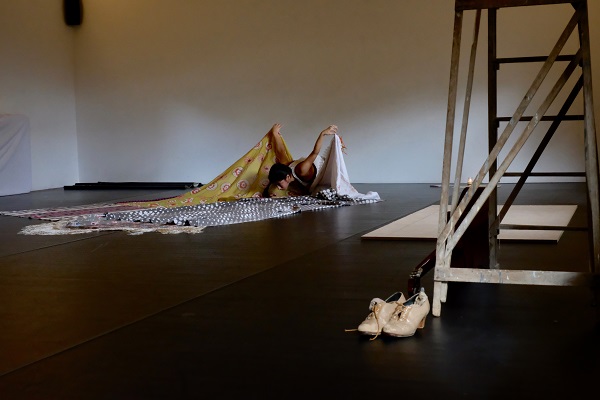26 MARCH 19:00. Javiera de la Fuente.
Second floor. (Work in progress, 40 minutes). // Free admission on a first come, first served basis
Like a new continent of movement experiences, CANTO A LO POETA refers to a popular tradition of Chile that consists of improvising, singing, establishing dialogues and creating poetry, a hybrid legacy of the Spanish colonisation. Based on this premise, Javiera is organising encounters with female artists and thinkers who use a contemporary language to establish dialogues with the poetic, sound and performative traditions of southern America and southern Spain.
"For the end of the world” is one of the topics or key principles on which poets reflect and declaim. Rethinking, saying and moving the end of what we know, shouting about the fall of failed power structures and, above all, proposing new ways of acting and imagining. During the intervention at the Museo CA2M, the interaction will be with the edges of Jorge Satorre’s exhibition.
In this context, Javiera pursues her research into some of the materials she has worked with in recent years: flamenco as device and language, the danced word, the voice as an extension of the body and memory, territory (and also the body) as a space enclosed yet simultaneously impossible to demarcate. A perpetual essay on how to recognise borders, and how to cross them. This cross-border subject has a southern perspective. A body that has come from the south of the south, given the world order, says and dances within imposed and imagined margins, liquid, migratable margins, sensitive fields that select and archive while forgetting and discarding to survive. After all, this is a ballad, a fondling of information, images, temporalities and references: What can bodies say/sing about things that happen... and about things that vanish? In the face of intuited (or certain) unsustainability, of imminent death... what would the last dance be? How would it look? And to save ourselves, would we dance together?
Javiera de la Fuente Llovet (Santiago de Chile, Seville) Trained in traditional and contemporary Sevillian dance, Javiera made her debut at the Jerez Festival in 2013 and has since danced on iconic stages and emblematic clubs and flamenco venues all over the world. Since collaborating in the Máquinas de Vivir project of Pedro G. Romero (2014), she has been working with languages closely related to performance, in non-conventional contexts and spaces. This has led her to unite critical thinking and dance into hybrid formats. Her most recent collaborations are the video Las Trabajadoras at the Museo Reina Sofía (Madrid 2021–22) and the performance Subir y bajar escaleras (MACBA 2022, IVAM 2023).
She also performed her dance lecture El Drama de una Realidad Sur at El Dorado and the Museo de la Virreina in Barcelona (2019). In 2020, together with the visual artist Isaías Griñolo, she premiered the flamenco artefact Luciérnagas at Tabakalera, Donosti (2021). In 2022 she directed and performed the piece Budapest 1934 at the Seville Flamenco Biennale. In 2023 she performed her show Envioletá at the Nîmes Flamenco Festival, which she had previously staged at the Museo Reina Sofía (2022), Centro Federico García Lorca (2022), Museo Carmen Thyssen in Málaga (2023 and 2024), Wadi Festival in Córdoba (Dec. 2023) and Centro Cultural Ex Hotel Royal in Valparaíso (Chile, 2024), among other venues. In 2024 her performance Exordio featured in the Aprendices Errantes exhibition by Cristina Mejías at Patio Herreriano (Valladolid). Her latest project is CANTO A LO POETA, in reference to a traditional form of poetry in Chile. She staged a work-in-progress version for the Ecologías de Paz exhibition of the Fundación TBA21 at C3A (Córdoba, 2024).

Javiera de la Fuente en Espacio Creativo Azala. Picture: Jorge Ferreira. Cortesía de la artista.